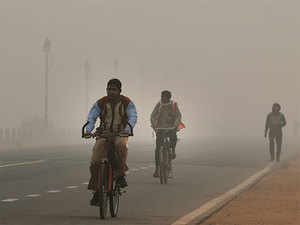
By Chris Kay and Iain Marlow ET
From his office in the smog shrouded city of Lahore, environment official Saif Anjum pores over reams of pollution data and lists the actions being taken by Pakistan’s largest province to combat the toxic air. He said they have arrested hundreds of crop-burning farmers and closed construction sites and industrial furnaces.
But those efforts risk being for naught without collaboration with Pakistan’s nuclear-armed arch-rival India.
The neighbors are grappling with farmers burning fields on their respective sides of the Punjab -- a fertile breadbasket region located in northwestern India and northeastern Pakistan -- that was torn in two by the partition of British India in 1947. Those fires, set to clear fields for the next crop, are worsening the deadly smog now choking the cities of Lahore and New Delhi.
“We have a common enemy,” Anjum, a retired Pakistani army captain and secretary at Punjab’s Environment Protection Department, said in an interview on Monday. “We have already requested the federal government for approaching the Indian side. Both sides need to work on it jointly, there’s no other way.”
While Anjum said formal discussions had not yet been held between the two neighbors, in a tweet last week the Punjab government in Pakistan said it had banned stubble burning and said it hoped India’s Punjab chief minister Amarinder Singh “takes similar measures.”
Despite a bloody history, the fates of 1.5 billion people in both India and Pakistan are increasingly at risk from developing hazards such as air pollution, not just conventional security threats. Air pollution is estimated to kill more than half a million Indians and Pakistanis every year, while the World Bank has said environmental degradation costs India $80 billion annually.
There are some precedents to solving cross-border issues, such as a river sharing treaty, but India--Pakistan ties are at a low-ebb, while domestic political considerations in India might make collaboration with Pakistan is impossible.
The foreign ministries from both countries didn’t respond to requests for comment.
Toxic Smog
“Environmental standards and climate change issues are new non-traditional security threats,” said Hina Lotia, the director of programmes at Leadership for Environment and Development Pakistan, an Islamabad-based think tank. “These issues are not any less important than the traditional disputes and differences that bedevil our relationship.”
In recent weeks, toxic smog has shrouded north India and parts of Pakistan. New Delhi, whose leader shut schools and called the city a “gas chamber,” has generated global headlines for its air pollution.
But many other cities across north India and in Pakistan also have high pollution levels. Lahore, the capital of Pakistan’s Punjab, has been covered in smog for weeks that has led to cancelled and delayed flights, as well as pileups on highways. The World Health Organization said air pollution in 2012 caused 612,000 deaths in India, and almost 60,000 deaths in Pakistan.
The causes are complex and range from vehicle and industrial emissions to construction and road dust. But a large part of the problem is crop burning. Because of the short window of time between harvesting rice and planting wheat in the same soil, it’s cheaper and faster for farmers to set the crop residue on fire rather than cart it away. When millions do this, the deadly haze can be seen from NASA satellites.
‘Dangerous Threat’
On the same day Punjab’s government reached across the border, a U.S. state department official warned Congress about the lingering likelihood of a nuclear conflict breaking out between India and Pakistan.
“Politics don’t allow the two countries to partner on such initiatives, even in cases where each side faces the same dangerous threat,” said Michael Kugelman, a senior associate for South Asia at the Washington-based Woodrow Wilson Center.
But even if national governments aren’t taking action, it makes sense for the two Punjab governments to coordinate policy, said Kartikeya Singh, who studies energy and sub-national governments at the Washington-based Center for Strategic and International Studies. “Why shouldn’t Punjab talk to Punjab?” he said.
Cross-border collaboration is possible on health matters, even if it is unlikely on military or territorial issues, said Ashok Swain, a professor of peace and conflict research at Sweden’s Uppsala University. India has been able to compartmentalize contentious aspects of its relationship with China, while moving forward on other issues such as trade, he said.
“It’s always easier for these contentious parties to agree on these types of issue which are environmentally critical,” he said.
Cooperation ‘Ideal’
While Delhi’s chief minister Arvind Kejriwal has blamed farmers in Punjab and Haryana, Singh of Punjab has called on Prime Minister Narendra Modi to take action.
In Pakistan, Punjab is dominated by the federally ruling Pakistan Muslim League-Nawaz, making anti-pollution measures easier to coordinate and impose across the province.
Yet actions from both governments will only slightly improve air pollution across the sub-continent due to the overall effects of climate change, said Qamar-uz-Zaman Chaudhry, the former head of the Pakistan Meteorological Department.
“Coordination will not drastically change the situation, but some improvements can be achieved,” he said from Islamabad. “Realistically both are suffering, so if they can cooperate that would be the ideal thing they can do.”
No comments:
Post a Comment